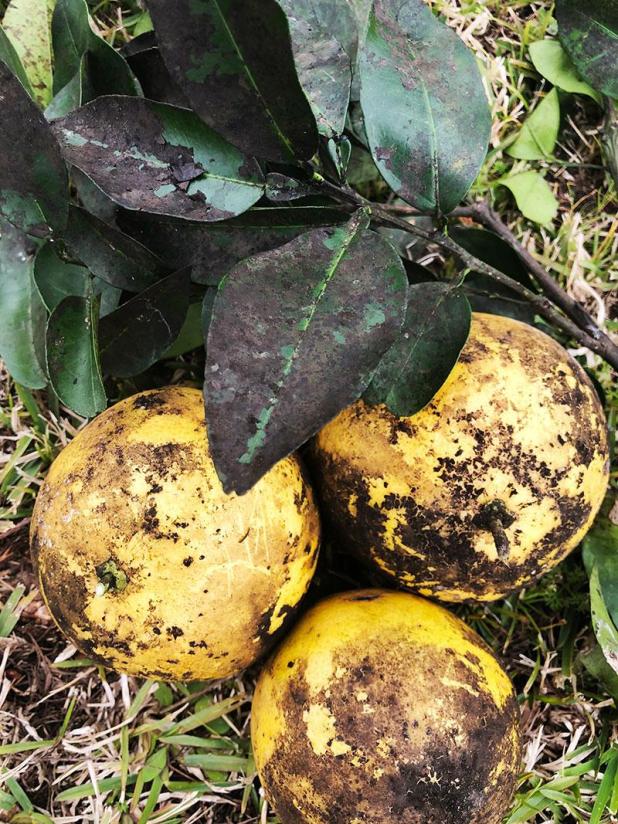
Whiteflies leave honeydew on citrus leaves and excrement that causes a sooty black fungus. (Submitted Photo/Courtesy of John K. Flores)
February work produces fall bonanza
If you have citrus trees in your yard, you probably already know that the first week of February is when you should really start paying attention to them.
For the past few weekends, my wife and I have been harvesting the last of our fruit crop, which happened to be one of those bumper years. I’m not sure if the bonanza we had was due to the extremely cold 2018 winter combined with an above average year of rainfall all the way up through fall, but whatever the reason, we couldn’t have been more blessed with our produce.
Now that the fruit is off the trees, this weekend I’ll go about the business of attending to them in preparation for this year’s yield. One of the first things I’ll do is fertilize them with a good dose of 8-8-8 or 13-13-13.
How much? Well, that depends. The old-school rule of thumb I used for years when the trees were young was for every foot of height I’d apply one pound of fertilizer. I make sure to distribute the material all around the tree evenly from the trunk to the outer most circumference of its branches.
Overall, it’s a pretty good rule of thumb. But, if you visit the LSU/AG Center’s Louisiana Home Citrus Production website, there’s a detailed chart and graphic that is an excellent resource when it comes to fertilizing your trees.
In our hobby orchard, we have a couple of satsuma trees, a blood orange tree, a grapefruit tree, a lemon and kumquat tree. What else we have is a problem with whiteflies.
The Farmer’s Almanac identifies these pests as aleyrodidae, which is a soft-bodied, winged insect, closely related to aphids and mealybugs. Whatever they are related to, they are a disgusting parasitic creature that sucks the juices from the leaves on your trees. What the flies leave behind is an excrement known as honeydew, which when left unattended becomes fungal disease.
If you’ve ever seen the black sooty film that almost completely covers the vibrant green leaves of a citrus tree, then you’ve seen the disease. It literally takes over the tree.
The fact is it’s nearly impossible to get rid of whiteflies. You’re in a constant state of prevention by treating over and over throughout the year.
The black fungus interferes with the physiological activities (photosynthesis) of the tree, where the tree becomes weak and will produce a small crop of tasteless, unappetizing fruit.
Some large commercial growers will often use biological controls to combat whiteflies. These may include the introduction of parasitoid wasps or ladybird beetles, which feed on whiteflies and their eggs. These types of controls may be good for the fruit farmer but are less practical for backyard hobbyist.
During an online search for getting rid of whiteflies, one site suggested using a vacuum cleaner to suck the insects off the leaves. Another said to hose down the trees often with water to control them. However, most people fight whitefly infestations with chemicals.
Typically, what I have used is Hi Yield 55 percent malathion insecticide spray, but there are other brands and chemicals on the market just as effective. For fungus, I’ve used Daconil Fungicide spray.
The problem with chemical treatment is with the application. Many people make the mistake of mixing a batch of chemicals thinking “more is better.” Chemicals are harsh and not only will they kill the target species of insects, they also kill many of the good ones that actually prey on whiteflies.
Additionally, some make the mistake of spraying when the citrus tree flowers are in bloom and subsequently kill the honeybees that are pollinating their fruit trees.
An organic spray can be made by mixing 1.5 tablespoons of liquid dishwashing soap, such as Dawn or Palmolive, with lemon, with 1 cup of vegetable oil. You can substitute Dr. Bonner’s liquid soap or Murphy Oil Soap. After mixing the two agents, shake them well. The dosage is 1.5 tablespoons of mix to 8 ounces of water.
Since I’m typically spraying by volume, if my math serves me correctly, I would use 5 quarts of mix in my 14-gallon commercial sprayer. Essentially, the mixture leaves a film on the leaves that kills whiteflies and smothers the larvae and eggs.
What’s key is whether you apply insecticide chemical spray or more gentle biodegradable homemade horticulture oils, they need to be applied on top “and” bottom of the leaves.
For coastal zone residents with citrus trees in their yards, the first couple of weeks of February are crucial for a healthy crop. If they do the work now, come fall the payoff could be a bonanza.
EDITOR’S NOTE: John Flores is The Daily Review’s Outdoor Writer. If you wish to make a comment or have an anecdote, recipe or story to share, you can contact Flores at 985-395-5586 or at gowiththeflo@cox.net
